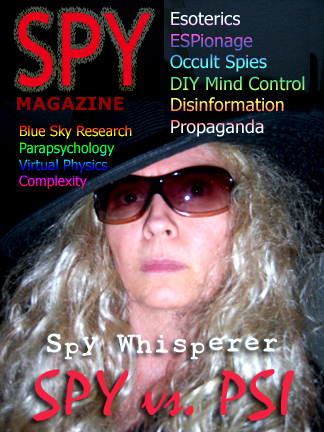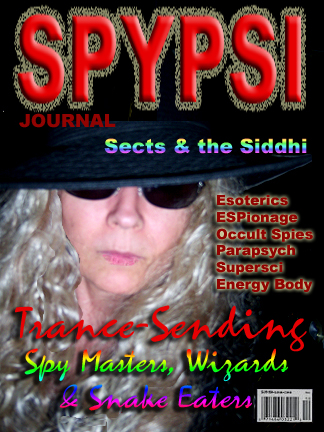Spy See Reviews
SPY SEE: Espionage Insiders on Spy Films
SPY SEE
Spy Film Reviews from Espionage Insiders
By Iona Miller, 10-2008
FORMULA: ACTION * CONSPIRACY * ESPIONAGE * SUSPENSE
"When a genre character …not only makes manifest our secret desires of power and fluidity, but also manages to transcend, subvert and conquer the rules and formalities of our little lives, well, that's why we still have spies up on the screen today." –Paul Mavis, The Espionage Filmography
"We are what we pretend to be, so we must be careful about what we pretend to be." –Kurt Vonnegut, Jr.
COMING ATTRACTIONS
Who doesn't love a good, tense spy thriller? Some of the very best films ground themselves in a gritty reality, focusing not on some fantasy or even thinly-veiled super secret spy organization, but on the CIA itself. This article focuses mainly on films that relate primarily to CIA. The benchmark films are listed at the end.
Certain mistakes permeate the most popular films. One is the distinction between CIA Case Officers who function as Spy Managers and their contract agents (spies). No one is both a spy and a spy manager. "Operatives" is never an official designation. Another distinction is between Counter Intelligence (CI) which is clandestine or secret and Covert Action (CA) which is paramilitary and includes plausible deniability.
The Intelligence Community (IC) currently includes 16 agencies (called elements) led by the Director of National Intelligence (DNI). Because of this restructuring the Director of the CIA no longer reports directly to the President, except through the daily briefing. ODNI, Office of Director of National Intelligence now also controls the purse strings of the reinvented IC, whereas the former manager, the DCI, did not.
The CIA is the only member of the intelligence community that doesn't fall under the oversight of a larger cabinet seat. The CIA's focus is collecting intelligence and conducting clandestine operations (CA - Covert Action) for counterintelligence (CI) overseas. Its analysis is used by the military, policymakers, defense planners and law enforcement. Four directorates include Intelligence, Science and Technology, Support, and the National Clandestine Service.
As part of the Defense Department, the head of the NSA reports to both the DNI and Under Secretary of Defense for Intelligence. Far larger than CIA, NSA is responsible for the nation's cryptology - keeping U.S. information secure, and cracking the codes of foreign nations - using and developing the latest technology. It also watches its own citizens via phone taps, cell phones, email and blanket surveillance.
NSA employs the largest staff of mathematicians in the country as well as analysts, profilers, engineers, linguists, and computer scientists. NSA is an ever-vigilante Big Brother. They might even watch CIA. Sometimes, they might watch movies about CIA like the rest of us. Or not, as one NSA agent wryly said, "I already saw the PLAY."
SINISTER SPECTERS
The best films focus on complex facts that change America. Just as we have myths of personal identity, we have myths of nation-state identity. Their portrayal and interpretation can change our ideas about ourselves as a nation. Like the dirty secrets of toxic families, nations can engage in abusive or toxic behavior.
Some accept and some reject CIA. CIA is a flawed system, often characterized as a sinister specter where the blame stops for myriad ills of society. Instead of superheroes and fierce gun battles, more realistic movies focus on spycraft, political maneuvering, disinformation, profiling, detective work, keen observation, and most importantly on very smart characters – those who fight with their brains instead of brawn. Because they aim to "entertain" rather than educate or inform, none of these films conform with practice.
Some movies focus on power plays on the Grand Chessboard, but there are also individual power plays among the players. As in real life, these quirky heroes and anti-heroes aren’t perfect. Some put personal interests above the mission. In "Quantum of Solace," Bond is accused by M of operating from revenge rather than orders. Others go to the mat for their charges to save their lives and careers. There are myths about "rogue institutions" and "going off the reservation." In spy slang, "Burn Notice" means a compromised agent is blacklisted or terminated.
Corruption is an international fact of life. Sometimes, these movies deal with the extreme creepiness of criminals in and out of government -- an "Enemy of the State." Infractions range from a host of human rights violations including torture, to betrayal, to procedural infractions. Case Officers know that torture is punishment not extraction of critical data. "Body of Lies" gives a nod to the shame and real repercussions of Guantanamo, as did "Rendition."
The dark side of the changing face of intelligence will likely be the subject of numerous future feature films. CIA’s “greatest hits” have been documented as well as their misses, as in "Charlie Wilson's War" and the 1997 TV film, “Bay of Pigs.” “Air America,” raised the specter of spooks dealing drugs, exposed 50 years of CIA arms supplying, international drug trafficking and narco-colonialism used to secure unaccountable black ops funding and foreign corporate markets.
The classic Jack Ryan movie, "Clear and Present Danger" shows CIA involvement and interdiction in the roots of the Columbian drug cartels. The 2007 release, "American Gangster" depicts the domestic fallout of Golden Triangle heroin in inner city urban areas.
So many of our clandestine and covert incursions, including the lost War on Drugs, take place in drug-producing countries. It's no accident. "Air America" showed CIA aiding Asian drug lords. Afghan opium is now a big international issue, setting the stage for a new heroin epidemic. The Mexican mob is growing it now, too, as well as cocaine. They are poised to grab the US meth and pot market. They are trying to monopolize the entire drug market making "Traffic" and "Blow" look like a walk in the park.
Perhaps we should be most afraid of what isn’t being shown, what isn’t being disclosed, what are still real state secrets. “Syriana” (2005) is probably still the quintessential topical CIA film. It is a common sense tale with the basic thesis that if you want to keep consuming petroleum products like there is no tomorrow then you are going to have to get used to pan-national corruption, designed poverty, terror-cell spawning, and doomed-to-failure empire gambits. It’s the spy, his enemies and the shadowy world that have secured the American lifestyle at the expense of others.
Feature films now compete with a new genre of low-budget independent documentary, “truth” or conspiracy films and idiosyncratic exposes, such as “Zeitgeist,”“Esoteric Agenda,” “JFK II,” and myriad 9/11 films. Each expresses a point of view alerting the citizenry to acts done in the name of our nation.
Some segments of the public have become de facto Digital Spies, using Open Source to track down facts and deduce patterns to satisfy their own ends. The spies are being spied on by the watchdogs, including those CIA veterans who have become disillusioned and know the "straw men," "dirty tricks" and "false flags" when they see them. They know the tales that "Wag the Dog."
SPY GENRE
Hollywood loves the spy genre which resonates with pop culture. Drama is inherent in these situations. The genre officially includes films that deal with undercover agents of any government, including FBI and CIA agents, postal inspectors, Army and Department of Treasury investigators, and other special government agents. The 2007 Academy Award winning German film, "The Lives of Others," is fair warning where obsessive monitoring can go. Totalitarian excess is a valuable lesson perhaps lost in a political climate that no longer even pays heed to "plausible deniability."
But the film world loves to focus on spies. The gamut includes propaganda films of World War II, the James Bond phenomenon, anti-communist spies of the Cold War era, military espionage in the eighties and nineties, and terrorism in naughties.
In 1973, the landmark spoof, "The Spook Who Sat Next to the Door" took on issues of discrimination at CIA and Black militancy. "Spook" was used as a racial slur, as well as slang for spy. This spook used his CIA paramilitary training to recruit militants. The story of hypocrisy and oppression has universal qualities. Soon after its release, this politically controversial film was suppressed. Now this political commentary is a radical time capsule, complete with stereotypes.
Spies thrill us and often rise to cult status. Spy films tend to fall into three categories. The formulaic range from the ultra-patriotic Jack Ryan stories to Bond films. The spoofy range from the suave “Our Man Flint,” "Matt Helm," and “Modesty Blaise” to the slick thriller "Mr. and Mrs. Smith" to the unabashedly puerile “Get Smart” and “Austin Powers” series. The wacky theories of Mel Gibson’s 1997 film “Conspiracy Theory” have become commonly accepted knowledge, no longer "fringe."
Sophisticated films focus less on gags than getting the tricky job done. They believably detail core principles and intelligence tasks beyond “bang & burn,” (demolition and sabotage), such as training, information gathering, risk assessment, security awareness and support, counter intelligence, recruiting, assassination, and double-crossing.
Still, all films deal with our cultural fantasies of such things more than facts. All are flawed from the operational perspective of espionage insiders. Spies don't operate on their own but under the direction of Case Officers - spy managers. As the tagline for "Spy Game" says, "It's not how you play the game. It's how the game plays you."
CIA is a maze of acronyms that mystify the uninitiated. The real culture of CIA is as difficult to capture as the intelligence it seeks. The chain of command makes it difficult to place blame, when even a George Tenet can be bullied by a President into doctoring intel analysis for a war agenda. Hence, most spy films are the slice-of-life variety. There are many hierarchical levels from the deep insiders of Skull & Bones to the Case Officers, translators, analysts, the man in the street, assets, and pawns. They surveille one another as well as the enemy. They are The Watchers.
In films we all get a rare chance to watch back, to observe the masters of disguise and duplicity. Many of our opinions of clandestine and black ops come from these fictional depictions. We never seem to tire of these observational tales, so we can expect more “buzz” and many more Coming Attractions. They help us collectively process the shadowy underbelly and deeper dark realities of global life that support the American way of life. Dramatic enactment is more powerful than a news or TV story. It lets us into their lives and experience -- the feelings.
WATCHING YOU WATCHING ME WATCHING YOU
Undeniably, the spy genre has tremendous box-office appeal. Each season brings the latest thriller. Our cultural myths play out in these films just as they do in the socio-political landscape of the Great Game. Myth is quite different than the blunt reality of espionage. The real fight is dirty, brutal and often illegal. It has repercussions – blowback. CIA is cast as the villain as often as not.
Aren’t governments accountable to their citizens? Thus, we have gritty cautionary tales on the hazards of working so closely with evil. They define who is a patriot and who is a traitor and who inhabits the No Man’s Land of moral relativism. The lines are blurry, so it can be tough to tell when they are crossed and double-crossed. They can wave the flag or show our secret shame and conflict. Dialogues hinge on leveraged trust and deceit.
Some of these movies are not so subtle propaganda for the left or right. Does the end ever justify the means? Does an immediate victory insure future retaliation? No nation ever really forgets anything whether the grudge remains secret or open. Muslims still call us The Crusaders. All wars are Cold Wars, including asymmetrical war. Fates of nations hang in the balance. Our fates hang in the balance.
SEEING IS DECEIVING
But, the turbulent life of CIA spy managers and spies isn't exactly what Hollywood makes it out to be. CIA cannot control its own public image entirely. Speaking to the political and social concerns of the times, spy films portray a matrix of values with greater or lesser accuracy and the formal dynamics of cultural complexity. Stereotypes don't always hold up. There are case officers with successful long-term marriages, for example. Intrigue, conspiracy, covert action and shadowy double-dealing make up the plot. Deconstructing society’s rules is what makes the spy genre tick.
Visual representations of this normally unseen agency is an evergreen subject. Perhaps it helps us enact and react to our national identity. It certainly shows us our collective shadow side even when that is hard to take. These films show us the uncertain landscape and morphing atmosphere of some of the world’s most dangerous and critical situations. Spy films are full of secrets.
DARK SHADOWS
Dirty secrets are at the core of every toxic family, and the dominant hand of the CIA is no exception ecause it must keep close secrets to fnction effectively. CIA is the scapegoat of the Shadow Government with its corporate greed and phony religious talk. It has created a national emergency and a Cult of Secrecy. CIA doesn't operate in a vacuum. It is a capitalist tool of the military industrial complex (MIC). The Shadow Government includes the Executive Branch, the Intelligence Branch, the War Department, the Weapons Industry, and the Financial Department.
Because of the fear-mongers, we are now scared of our own collective shadow, everything we have denied and projected as a nation. Ethnic, religious and racial stereotyping is projection, the root of the blame frame which identifies the enemy. We are in the midst of global financial meltdown. No longer backed by the unquestioned "might is right" military capacity of the US, the Greenback is failing and taking Europe and Asia with it. Civil liberties have been subverted in the process, confirming our worst fears.
We have met the enemy and it is us. All this is fodder for filmmakers, led by Oliver Stone's new spoof of George "W." Sometimes, what can you do but laugh at the absurdity?
CINEMATIC SURVEILLANCE: Films explore the creative space between action and identity. The spy genre explores the potential in masquerade where identity is conditional – a fashioned self. Things are never what they seem; there is always a mind-bending twist. The viewer has the enviably safe position of the Observer Self, free to come to a personalized view of unfolding events. One gets to participate as the innocent caught up in clandestine activities, then go home unscathed to order pizza.
There are lots of spy and spy-fi movies but most of them bear little resemblance to reality, nor do they try to do so, even when they have knowledgeable consultants who know better. Films are made in the editing room, long after shooting. But while we watch the movies, the public is watching the spies back while the filmmakers simultaneously shape their opinions. Some might call that mind control stronger than any of that exerted by CIA. Often they show us our folly, or hidden truths, such as "Lords of War," in which illegal arms dealers receive political protection at the highest level. After all, small wars are good for business, or are they?
CONSENSUS NARRATIVE: Films make us see things in a certain way and it may be difficult to distinguish fact from fancy in this genre where the real and unreal meld as “friction.” This friction is a defining characteristic of the faultlines of our collective societal values, which films mirror back to us. But the mirroring can be as spurious as forged documentation. They reveal our collective identity crisis.
Do we find self-justification in such cathartic experiences? Does it make us receptive to new policies? It is not simple viewing – SPY SEE -- but also is “in-forming,” making something of us we would not be otherwise. For example, the Oliver Stone film "JFK" caused most people born after the event to consider Stone’s version (ased on Jim Marrs's books) the historical summary of the assassination.
DYSTOPIAN THEMES: In this context, we are most interested in those serious films that deal either with real issues or actual events or depict untold history from behind the scenes. These are the most politically relevant and potentially explosive despite the success of more fanciful stories with superheroes like Arnold Schwarzenegger or Tom Cruise. "Charlie Wilson's War" depicts a moment of seeming triumph on the world stage later followed by the blowback of 9/11 when the same players bit the hand that fed them. But here all we see is the big "Win."
Depending on the political climate, each decade has its own style of narrative, often based on a best-seller book. They range from cloak and dagger to exposes to virtual science fiction, varying with the market or trends they seek to tap. Topical issues now include “terrorism,” “ghost detainees” and torture. “Lions for Lambs” showed recruiting techniques used in universities to tap talent and carried a strong political message. Movie portrayals of covert operations have to an extent mirrored events in the real world, including the hottest new technologies and the power-driven sins of the military-industrial complex.
SPOOFING SPOOKS: The spy game is often the butt of the joke. Intelligence is made to look less than intelligent and like any bureaucracy, sometimes it is. Protocols are shamelessly breached with operatives [sic] recklessly dating foreign nationals or one another. Most spy films are obsessed with mechanical execution of the mission at any cost, technology, manipulation, and the game of spy vs. spy. Sometimes it takes outwitting one's own bosses. They share relentless taut action in a murky world. Sometimes there are real pratfalls. To fall hard means to die hard.
SCIENCE & CIA: Wizards, Weapons, Tools & Gadgets
SPY TECH: The 21st century intelligenda includes comprehensive intelligence and full-spectrum dominance -- surveillance via satellite, cell phone and other electronics turned against their owners, often remotely (ELINT, SIGINT). In the Cold War, those in lab coats were as important as those in the cloak and dagger end. Their daggers were laser pointers. Super scientists and their devastating inventions can be more dangerous than any field agent. It is the "Dr. Strangelove" syndrome.
Spy tech exploits technology for intelligence collection. Most cities now have Spy Stores where you can view and purchase exotic gear, from Nanny Cams to mini recorders. Inventions of the past are now common in daily life. Artificial Intelligence (AI) is used to ferret out and collate data from the glut of information. It acts as a sieve of information for analysis. Sometimes it performs analysis.
In the Cold War, CIA had a Directorate of Science & Technology (DS&T) where the “Wizards” of Langley produced fantastic state of the art gear. DS&T eventually split into the Clandestine Information Technology Office, the Office of Advanced Analytical Tools, and the Office of Advanced Projects. The unified team of CIA has been split into many areas of specialization and removed from the core of the spy agency.
The Office of Advanced Analytical Tools (AAT) was replaced by the Office of Advanced Information Technology (AIT), which had a somewhat broader mandate. AIT was disestablished in 2001, with some of its functions transferred to the CIA’s new chief information officer. An Office of Advanced Technologies and Programs replaced most of the Office of Research and Development.
New alignments eliminated the Clandestine Information Technology Office (CITO), which had been a joint activity of the DS&T and the Directorate of Operations. Some of CITO’s activities were transferred back to the Office of Technical Collection, while others were transferred to a newly created Information Operations Center in the Directorate of Operations.
CIA originally became heavily involved in photographic and electronic intelligence collection (non-agent ELINT) to reduce vulnerability – from radar, aircraft, ground stations, ships, and eventually satellites. Many missions, including space reconnaissance, were split from CIA and became their own agencies that included monitoring missile deployment and military applications (joint CIA – DoD operations).
There are currently at least 16 specialized intelligence groups in the Intelligence Community (IC) with a bewildering number of acronyms for agencies and operations. Separate directorates were set up for imagery and SIGINT (NIA, NRO). Defense Advanced Research Projects Agency (DARPA) led to the creation of the Internet.
With mixed success in the past, CIA laid the groundwork for many innovations. The cell phone, stealth technology, digital photography, encryption and decryption, Global Positioning System (GPS), disc media storage, chip technology, bugs and transmitters, non-lethal weapons and hand held computers first appeared in spy fi as quantum technological advances.
DARPA leads the pack in out-of-the-box thinking and literal "killer apps." Some say the HAARP installation in Alaska sends out a signal that creates mass brainwashing for political apathy -- for controlling the entire population. Its inventor could not argue against this possibility. The war for our minds is on. Bioengineering, germ warfare, and planetary engineering conceal terrible dangers.
CIA had their own reconnaissance satellite “Google Earth” in the early 80s. Now real-time surveillance is enhanced by unmanned drones and other techniques recently depicted in “Body of Lies” and “Eagle Eye.” There is a virtual roadmap in IT ‘space’ which requires expert navigation and maximal security. The risks are different but the stakes are enormous, including international funds transfer and laundering of black ops receipts through secret accounts.
IT ‘SPACE’
Information security (INFOSEC) is a critical enabling technology, including strong encryption, data integrity, remote users, knowledge generation, and access control. CIA’s problems are market drivers. Team-oriented synergy creates quantifiable solutions. In 1998, CIA could not compete for information technology and IT innovation, incubator teams, and talent with the same speed and agility as those in the commercial marketplace.
In-Q-Tel, a nonprofit corporation openly affiliated with the Agency, was created for alliances between CIA, academia and the private sector – outsourcing to insure CIA remains at the cutting edge of IT. In-Q-Tel does not require Agency approval for the business deals it negotiates.
The partners retain title to innovations they create. As such, In-Q-Tel represents a different approach to government R&D. Currently, the whole government is heading toward a model of “cloud computing,” or “cloudification.” The cloud is a metaphor for the Internet, an abstraction for the complex infrastructure it conceals. The new contract model spurs innovation.
ESOTERIC CIA AGENDA
In the infamous MKULTRA program, esoteric drug trials were included as “special” interrogation methods and a means to disrupt the enemy. Mind control techniques became infamous in films such as “The Manchurian Candidate,” depicting remotely deployed assassins in deep cover. “Telefon,” and “Jacob’s Ladder,” portraying BZ experiments in Vietnam, are also iconic mind control and experimental drug films.
Esoteric means, including Remote Viewing and “Spirit Comm,” were included in comprehensive surveillance. Thirteen million dollars later, the Cold War results of “Stargate” were dubious, at best. Now these former CIA wizards, psychic warriors and the clones they spawned have hit the lucrative lecture circuit to teach their psi-ops techniques to all comers. It gave new meaning to ESPionage. But was the project terminated or did it just permeate?
Remote Viewing is a form of HUMINT. “Suspect Zero,” with Ben Kingsley demonstrates a demonized twist on the premise. Remote viewers are trained by FBI to get into criminals' heads and witness crimes through a kind of heated red haze. But “Eagle Eye” and “Body of Lies” also show the superior value of HUMINT, for example, when the adversary goes off the electronic communications grid. Then one must deal with human intuition not just signals.
The military, in its zeal for total dominance of air, sea, land, space, cyberspace, and media/info is now investigating "transcendent intelligence" and "transcendent warfare." That means the ability to conceptualize and actualize an entirely new form of asymmetrical warfare that utterly transcends all previously known models. Remote Viewing the future is another option extending normal consciousness by downloading from the Collective Unconscious. http://farshores.org/sc06rv.htm
A Marine Corp War College report (Bremseth, 2001) describes the military invasion of sacred space. They envision transcendent operations for transcendent solutions, including threat assessment. They call it non-linear, multidimensional, even metaphysical. It includes remote viewing and other forms of anomalous cognition (AC) - both psi-powers or ESP. The proactive approach is aimed at exploring and advancing human / institutional potential, dynamic thinking and visionary leadership. "Stargate" rides again! It's a perennial paranormal theme. 16th century Magus, John Dee was a spy for Elizabeth I who used a scrying mirror for remote viewing.
“Electronic doping” with directed energy weapons, non-lethal weapons and HAARP are issues we are likely to see in cinema soon. The new war is a psyops war for the minds of mankind. They can now crawl up inside your head and manipulate your own thoughts. This mechanism has been suggested for the epidemic of "lone gunmen" like the one at Virginia Tech. You have to ask, "Who does this serve?"
UNBONDED: Some films are based on formulas, occasionally they are innovative. James Bond confuses the roles of Case Officer and field spy, a situation that does not occur in real espionage. Some films are based in mythologizing, others in de-mythologizing. In some, the license to kill is glorified; in others morality is not so clear-cut. There is usually "Collateral Damage." The vagaries of clandestine service are exploited. All require certain dramatic elements: the set up, unfolding, the climax and the reveal.
Rigorous training prepares field officers for clandestine operations but how much of the training is actually used when spying? "The Recruit" was a good example of the nature of training. Yet, how much actual technique can be packed into one story? The Directorate of Operations was responsible for transporting personnel and devices to their clandestine locations and installing and extracting them.
THE REAL INTELLIGENDA
CIA veteran Case Officer, Leutrell "Mike"Osborne, Sr. says even seemingly realistic CIA films are way off base describing operations. An ex-CIA spy master tells us what it's like on the inside of this top-secret organization and what he went through as a CIA spy manager in 30 foreign countries and as a Case Officer at Langley. This work relied as much on personal diplomacy as threats or clandestine action to recruit valuable human intelligence (HUMINT). As a Counter Intelligence expert, Osborne did not engage in Covert Action and deplores it.
In order to tell about personal experiences, all books and movie projects by former CIA staff must be vetted by "The Company." Therefore, many choose to fictionalize their tales for greater freedom and to pump up the dramatic story line. Firstly, no one is even supposed to openly declare what countries they've worked in. Spy Managers are often under cover as diplomatic personnel, certainly a euphemism. There is no such designation as CIA "operative" [sic]. There are Case Officers, Agents, and Assets.
Leutrell M. Osborne, Sr. of Annapolis, MD, was a spymaster for the CIA. James Bond he’s not, but then neither is anyone else, for Bond is portrayed in overlapping roles as both agent and officer. Case Officers function more like spy managers over independent contractors (agents, assets and recruits), overseeing select operations within their respective specialties. They are deployed periodically outside Langley as Field Officers.
Operations include three types: 1) Intelligence, or collection of information, 2) Counter Intelligence (CI) to prevent or stop foreign intrusion; and, 3) Covert Action (CA). Other CIA activities include analysis and projections. Osborne’s specialty was and still is CI – counter intelligence. Many tricks are employed to reach tactical goals, including propaganda, mind control, infiltration, as well as creation and support of insurgents.
Intelligence is one form of control system. Other control systems on the minds of large populations include education (controls behavior), money (controls wealth), law (controls authority), politics (controls national will), economy (controls wealth), history (controls beliefs), psychology (controls thinking), philanthropy (controls opinion), medicine (controls health), religion (controls spiritual beliefs), media / propaganda (controls culture, opinion), and continuity of succession (controls power).
CIA is not the only intelligence agency, but it is deployed by and reports to the U.S. President. There are now 16 intelligence collection agencies (IC) coordinated by the DNI. They include military intelligence, information operations (IO, Intellipedians), satellite and electronic surveillance (SIGINT), science intelligence, even domestic spying and homeland security.
"Law enforcement in the USA has already changed to acquire some of the attributes of intelligence work. That's why FBI SAs are now going to CIA for training. That's why USA is fighting with dirty tricks, aka CA, aka terrorism, formerly known as secret para-military warfare."
“For the record,” Osborne says, “the continued preoccupation with reducing vulnerabilities is costly and just the opposite of what the 'Osborne Ultimatum' recommends. We recommend more and improved HUMINT. Intelligence is a property of human beings.”
"When did the DNI's new leadership start determining that we had to give up rights so we can protect a vulnerability in our nation-state's security? How about suggesting that the DNI send a message out to the agencies and departments to do a better and stronger job at conducting Human Intelligence collection operations? We just might find out who and what the adversaries are doing. Thus, we don't have to give up our rights." Osborne has developed a Freedom Program to "counter those activities reducing freedoms, including dirty tricks such as Cointel Pro."
Osborne is currently offering his consultancy services to Hollywood in hopes of improving the accuracy of cinematic story lines about CIA activity.
BENCHMARK CIA FILMS
THE MANCHURIAN CANDIDATE (1962 - 2004), THE SPY WHO CAME IN FROM THE COLD (1965), DAY OF THE JACKEL (1973), THE CONVERSATION (1974),THREE DAYS OF THE CONDOR (1975), TELEFON (1977), HOPSCOTCH (1980), THE OSTERMAN WEEKEND (1983), THE INSIDE MAN (1984), THE FALCON & THE SNOWMAN (1985), NO WAY OUT (1987), THE RUSSIA HOUSE (1990), AIR AMERICA (1990), JACOB’S LADDER (1990), JACK RYAN SERIES· The Hunt for Red October(1990) – Alec Baldwin· Patriot Games (1992) – Harrison Ford· Clear and Present Danger (1994) – Harrison Ford· The Sum of All Fears (2002) – Ben Affleck· Without Remorse (TBD) – Ryan Gosling, SNEAKERS (1992), MOTHER NIGHT (1996), THE ASSIGNMENT (1997), ENEMY OF THE STATE (1998), RONIN (1998), RAINBOW SIX (1998), ALDRICH AMES: Traitor Within (1998)
THE OPERATIVE (2000), SPY GAME (2001), THE TAILOR OF PANAMA (2001), THE BOURNE TRILOGY (2002-2004-2007), CONFESSIONS OF A DANGEROUS MIND (2002) questionable “memoir,” THE RECRUIT (2003), SECOND NATURE (2003), TARGET OF OPPORTUNITY (2004), ICON (2005), SYRIANA (2005), MUNICH (2005), THE GOOD SHEPHERD (2006) CIA inner workings; James Jesus Angelton, RENDITION (2007), LIONS FOR LAMBS (2007), BREACH (2007) FBI traitor to the Russians, CHARLIE WILSON’S WAR (2007) Soviet/Afghan War, BURN AFTER READING (2008) Spoof, BODY OF LIES (2008) Iraq/Jordan hunt for terrorists, EAGLE EYE (2008) Spy-fi domestic super-surveillance by AI, TAKEN (2008), QUANTUM OF SOLACE (2008) Bond, Traitor (2008), DUPLICITY (2009) MI6 marries CIA - mayhem ensues, Men Who Stare At Goats (2009) true life psi-fi of First Earth Battalion psi guy resurrection for Iraq War.
REFERENCES and further reading
Richard M. Bissell Jr., with Jonathan E. Lewis and Frances T. Pudlo, Reflections of a Cold Warrior (New Haven: Yale University Press, 1996)
Paul C. Crickmore, Lockheed SR-71: The Secret Missions Exposed (Oxford: Osprey, 1997)
Dwayne A. Day, John Logsdon, and Brian Latell, Eye in the Sky: The Story of the CORONA Spy Satellites (Washington, D.C.: Smithsonian, 1998)
John Marks, The Search for the “Manchurian Candidate” (New York: Norton, 1988)
Antonio J. Mendez, The Master of Disguise: My Secret Life in the CIA (New York: Morrow, 1999)
Gregory W. Pedlow and Donald E. Welzenbach, The CIA and the U-2 Program, 1954-1974 (Washington, D.C.: Center for the Study of Intelligence, 1998)
Chris Pocock, The U-2 Spyplane: Toward the Unknown: A New History of the Early Years (Atglen, Pa.: Schiffer, 2000)
John Prados, The Soviet Estimate: U.S. Intelligence Analysis and Russian Military Strength (New York: Dial Press, 1982)
Jeffrey T. Richelson, The Wizards of Langley: Inside the CIA’s Directorate of Science and Technology (Boulder, Co: Westview, 2001)
Bridis, Ted. "The CIA Dept. of Quirky Tricks: Agency Reveals Gadgets, but You Can't See Them." Washington Post, 31 Dec. 2003, A17. [http://www.washingtonpost.com]
Doel, Ronald E., and Allan A. Needell. "Science, Scientists, and the CIA: Balancing International Ideals, National Needs, and Professional Opportunities." Intelligence and National Security 12, no. 1 (Jan. 1997)
Finn, Peter. "At CIA, a Vocation of Imitation." Washington Post, 8 Sep. 1997
Kroger, Charles A., Jr. "ELINT: A Scientific Intelligence System." Studies in Intelligence 2, no. 1 (Winter 1958): 71-83
Mendez, Antonio J. "A Classic Case of Deception." Studies in Intelligence (Winter 1999-2000): 1-16.
Mendez, Antonio J., with Malcolm McConnell. The Master of Disguise: My Secret Life in the CIA. New York: Morrow, 1999.
Mendez, Antonio and Jonna Mendez, with Bruce Henderson. Spy Dust: Two Masters of Disguise Reveal the Tools and Operations that Helped Win the Cold War. New York: Atria, 2002.
Minnery, John. CIA Catalog of Clandestine Weapons, Tools, and Gadgets. Boulder, CO: Paladin, 1990.
************
The IC consists of 16 members (also called elements). The Central Intelligence Agency is an independent agency of the United States government. The other 15 elements are offices or bureaus within federal executive departments. The IC is led by the Director of National Intelligence, whose office, (ODNI), is not listed as a member of the IC.
- United States Department of Defense
- Air Force Intelligence, Surveillance and Reconnaissance Agency (AF ISR or AIA)
- Army Military Intelligence (MI)
- Defense Intelligence Agency (DIA)
- Marine Corps Intelligence Activity (MCIA)
- National Geospatial-Intelligence Agency (NGA)
- National Reconnaissance Office (NRO)
- National Security Agency (NSA)
- Office of Naval Intelligence (ONI)
- Air Force Intelligence, Surveillance and Reconnaissance Agency (AF ISR or AIA)







